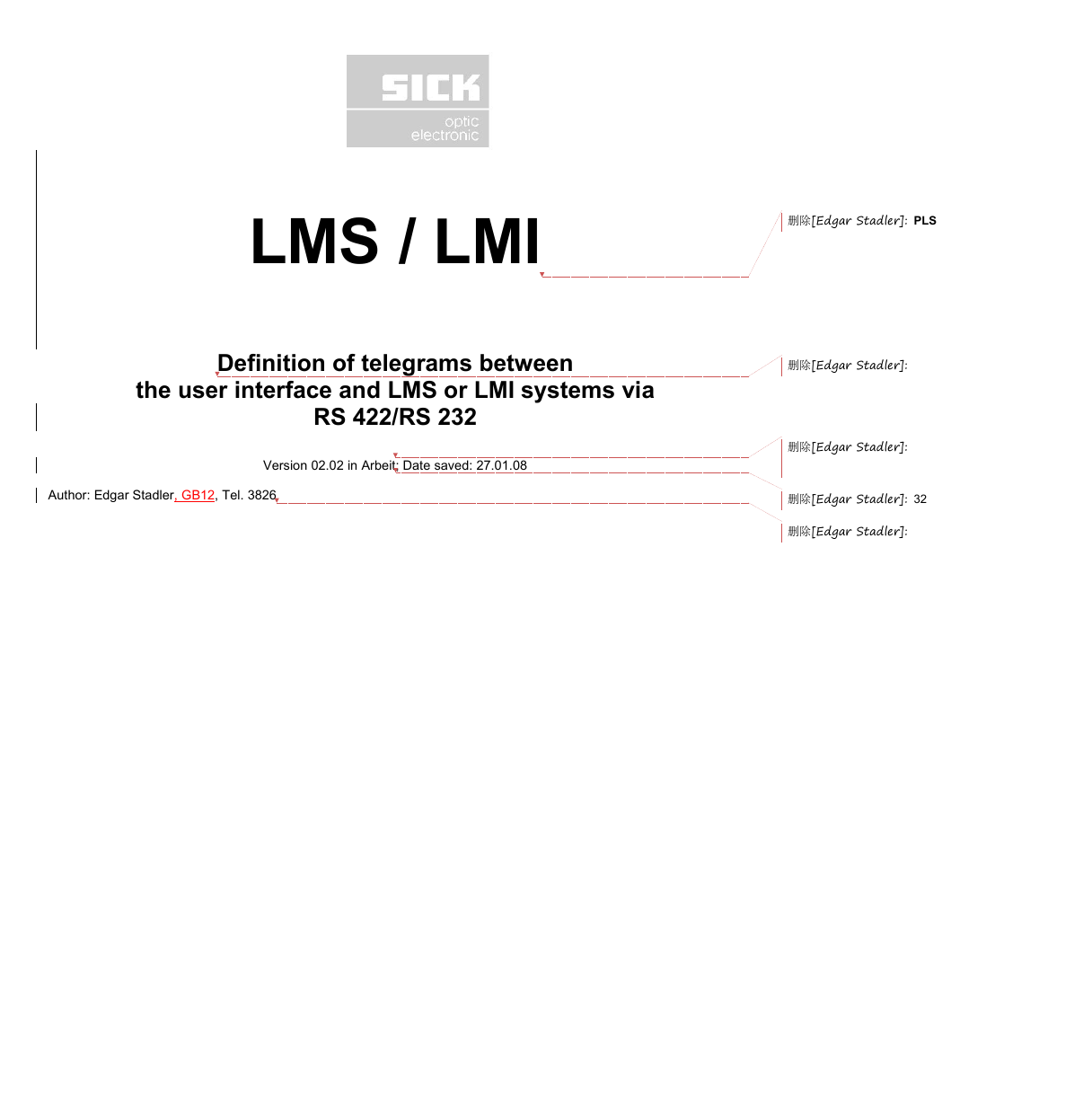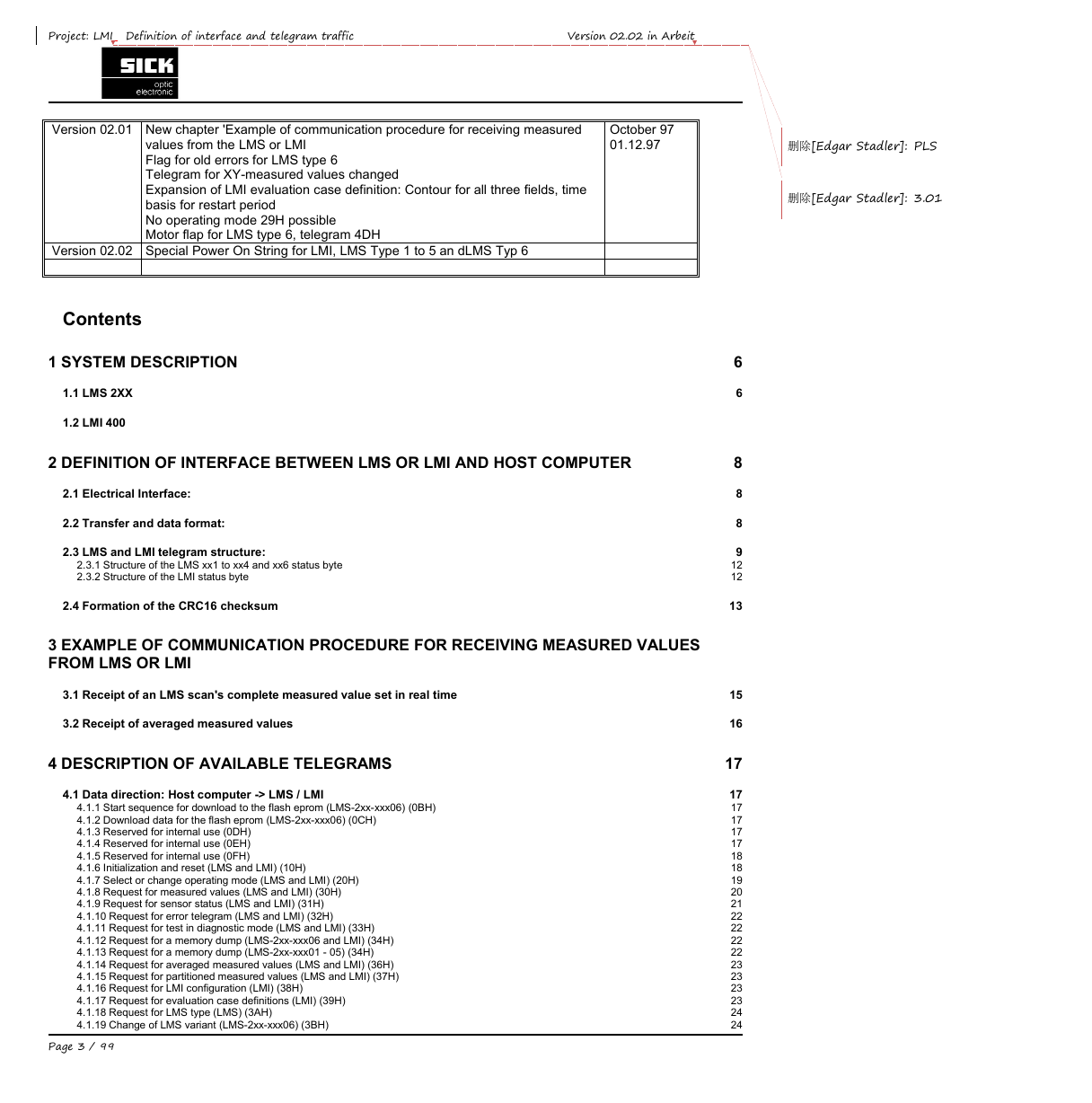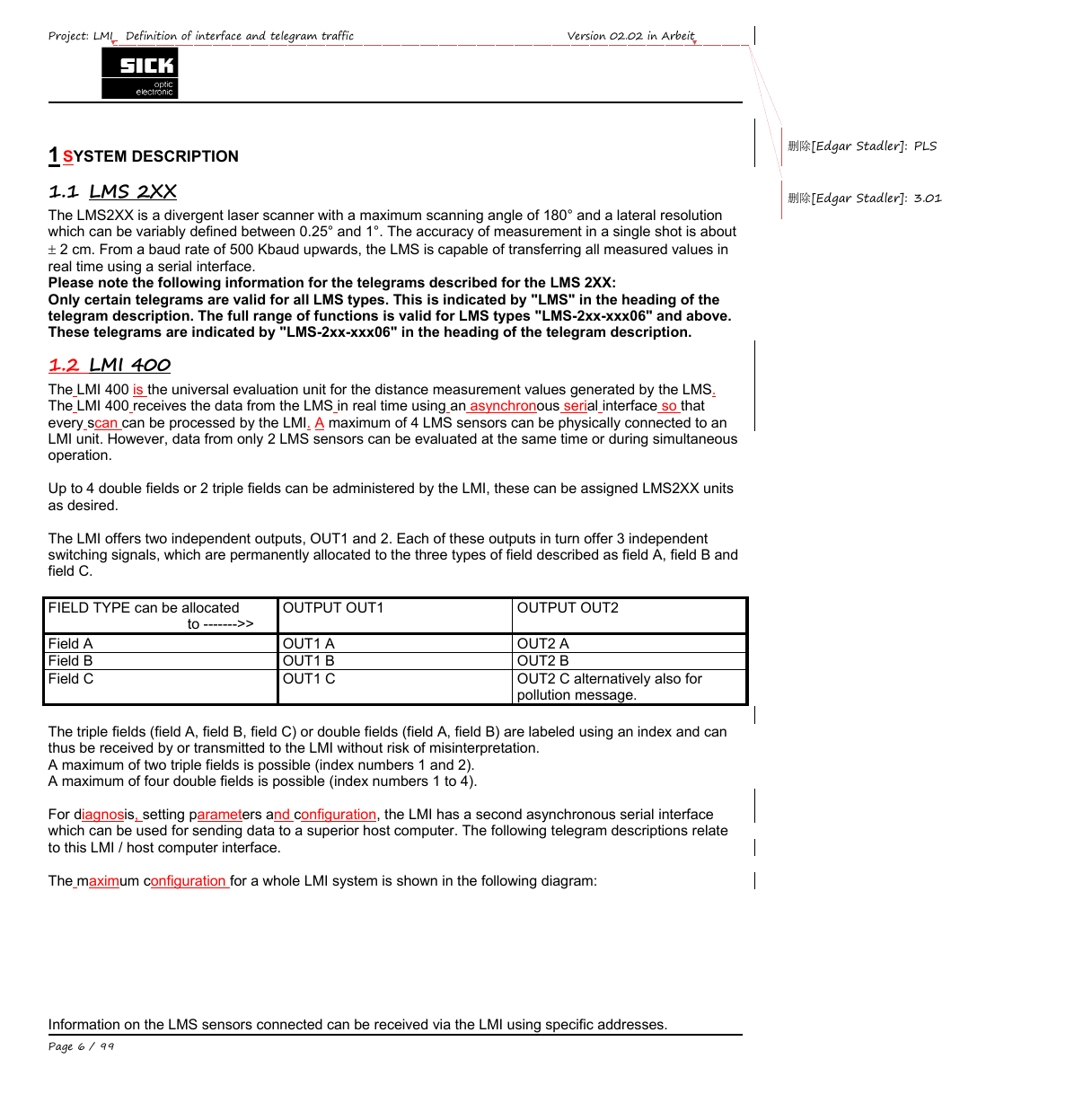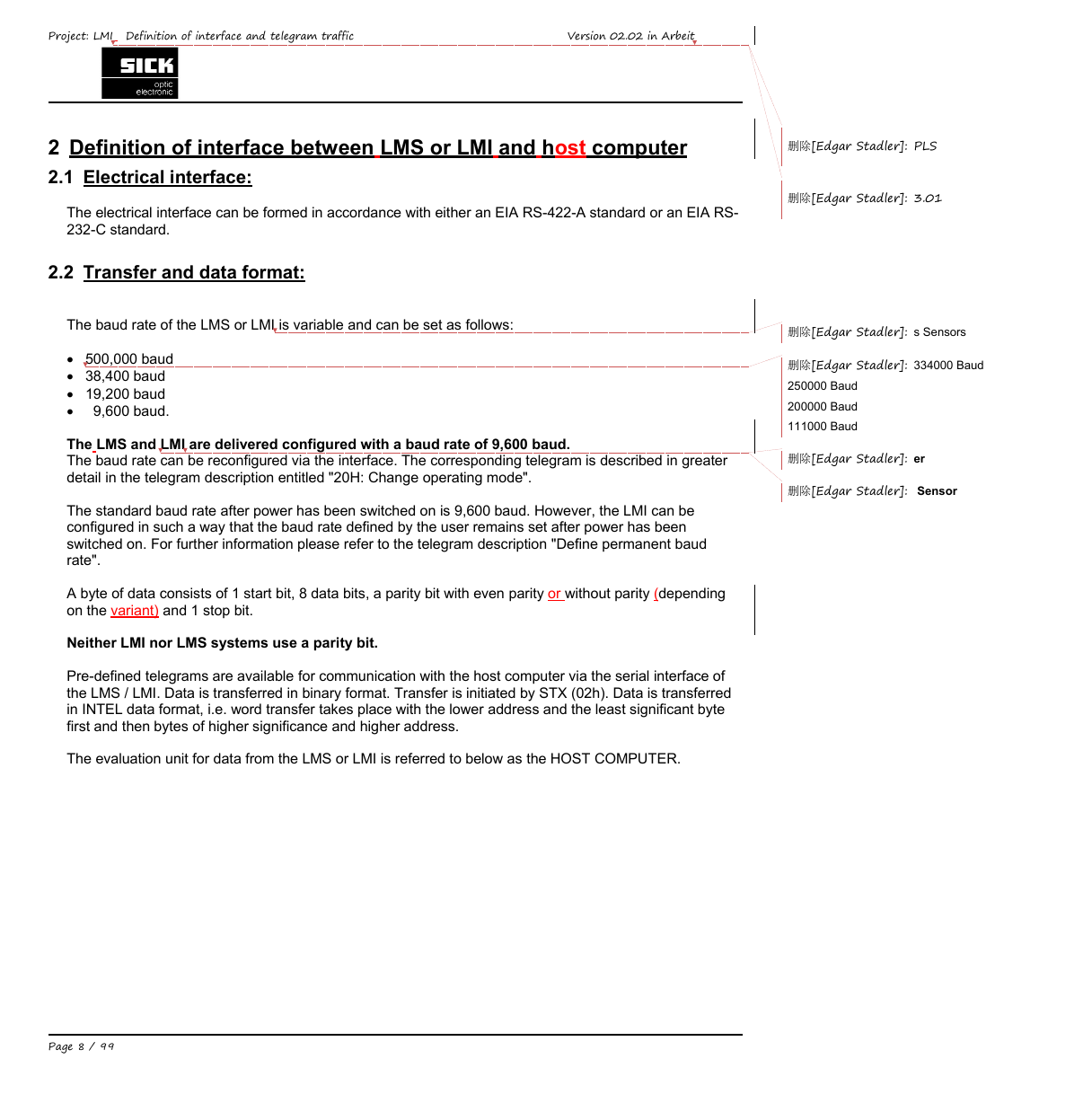1.1LMS 2XX
1.2LMI 400
2Definition of interface between LMS or LMI and hos
2.1Electrical interface:
2.2Transfer and data format:
2.3LMS and LMI telegram structure:
2.3.1Structure of the LMS xx1 to xx4 and xx6 status byt
2.3.2Structure of the LMI status byte
2.4Formation of the CRC16 checksum
3Example of communication procedure for receiving m
3.1Receipt of an LMS scan's complete measured value s
3.2Receipt of averaged measured values
4Description of available telegrams
4.1Data direction: Host computer -> LMS / LMI
4.1.1Start sequence for download to the flash eprom (LM
4.1.2Download data for the flash eprom (LMS-2xx-xxx06)
4.1.3Reserved for internal use (0DH)
4.1.4Reserved for internal use (0EH)
4.1.5Reserved for internal use (0FH)
4.1.6Initialisation and reset (LMS and LMI) (10H)
4.1.7Select or change operating mode (LMS and LMI) (20H
4.1.8Request for measured values (LMS and LMI) (30H)
4.1.9Request for sensor status (LMS and LMI) (31H)
4.1.10Request for error telegram (LMS and LMI) (32H)
4.1.11Request for test in diagnostic mode (LMS and LMI)
4.1.12Request for a memory dump (LMS-2xx-xxx06 and LMI)
4.1.13Request for a memory dump (LMS-2xx-xxx01 - 05) (34
4.1.14Request for averaged measured values (LMS and LMI)
4.1.15Request for partitioned measured values (LMS and L
4.1.16Request for LMI configuration (LMI) (38H)
4.1.17Request for evaluation case definitions (LMI) (39H
4.1.18Request for LMS type (LMS) (3AH)
4.1.19Change of LMS variant (LMS-2xx-xxx06)(3BH)
4.1.20Request for reference target values (LMS-2xx-xxx06
4.1.21Request for correction values (LMS-2xx-xxx06) (3DH
4.1.22Request for averaged partitioned measured values (
4.1.23Configuration of fields A, B or C (LMS-2xx-xxx06 a
4.1.24Change active field group (LMS- 2xx-xxx06) (41H)
4.1.25Change password (only in installation or calibrati
4.1.26Request for configured fields (LMS-2xx-xxx06 and L
4.1.27Teach mode for field configuration (LMS-2xx-xxx06
4.1.28Configuration of a dynamic rectangular field (only
4.1.29Configuration of a dynamic segmented field (only i
4.1.30Activation of a dynamic field using index or simul
4.1.31Activation / deactivation of outputs (LMS and LMI)
4.1.32Read the state of the inputs (LMI) (4EH)
4.1.33Define or simulate input information to change an
4.1.34Carry out calibration (only in calibration mode )
4.1.35Define permanent baud rate or sensor type (only in
4.1.36Define LMS or LMI address (only in installation or
4.1.37Activate / deactivate laser transmitter (LMS) (68H
4.1.38Definition of LMI configuration
4.1.39Definition of an evaluation case
4.1.40Read LMS configuration (LMS-2xx-xxx06) (74H)
4.1.41Request for measured values in Cartesian co-ordina
4.1.42Define LMS-2xx-xxx06 configuration
4.1.43Definition of correction parameters
4.2Data direction LMS / LMI -> Host computer
4.2.1Reserved for internal use (8DH)
4.2.2Reserved for internal use (8EH)
4.2.3Reserved for internal use (8FH)
4.2.4Message after Power On (response from LMS and LMI)
4.2.5Confirmation of software reset telegram (response
4.2.6Not acknowledge (response from LMS and LMI) (92H)
4.2.7Response to change of operating mode (A0H)
4.2.8Response to request for measured values (response
4.2.9LMS sensor status (LMS-2xx-xxx01 to 04) (B1H)
4.2.10LMS sensor status (LMS-2xx-xxx06) (B1H)
4.2.11LMI status (B1H)
4.2.12Error message / test message (response from LMS an
4.2.13Memory dump on request (only in diagnostic mode) (
4.2.14Memory dump on request (only in diagnostic mode) (
4.2.15Send averaged measured values (response from LMS a
4.2.16Send partitioned measured values (response from LM
4.2.17LMI configuration data (B8H)
4.2.18Definition of data for an evaluation case (LMI) (B
4.2.19Information on LMS type (LMS) (BAH)
4.2.20Response to change of LMS variant (LMS-2xx-xxx06)
4.2.21Reference target values (LMS-2xx-xxx06) (BCH)
4.2.22Correction values (LMS-2xx-xxx06) (BDH)
4.2.23Send averaged partitioned measured values (LMS and
4.2.24Response to field configuration (LMS-2xx-xxx06 and
4.2.25Change active field group (LMS- 2xx-xxx06) (C1H)
4.2.26Confirmation of new password (LMS and LMI) (C2H)
4.2.27Configuration data for programmed fields (LMS-2xx-
4.2.28Response in teach mode (LMI and LMS-2xx-xxx06) (C6
4.2.29Response to configuration of a dynamic rectangular
4.2.30Response to configuration of a dynamic segmented f
4.2.31Response to switching of dynamic field using index
4.2.32Response to activation / deactivation of outputs (
4.2.33Current input data (LMI) (CEH)
4.2.34Response to definition of input information for an
4.2.35Response to calibration (response from LMS and LMI
4.2.36Response to permanent baud rate definition (respon
4.2.37Response to definition of LMS / LMI addr
4.2.38Response to activate / deactivate laser transmitte
4.2.39Response to LMI configuration
4.2.40Response to definition of an evaluation case
4.2.41Current LMS configuration (response from LMS-2xx-x
4.2.42Response to request for measured values in Cartesi
4.2.43Response to definition of LMS-2xx-xxx06 configurat
4.2.44Response to definition of correction parameters
5OVERVIEW OF AVAILABLE TELEGRAMS
5.1Data direction: Host computer -> Sensor
5.2Data direction: Sensor -> Host computer
6LIST OF ERROR NUMBERS FOR LMS AND LMI
6.1LMS (LMS-2xx-xxx01 to 4) error list
6.2LMS (LMS-2xx-xxx06) error list
6.3LMI error list
7ABBREVIATIONS AND NOTES
















 2023年江西萍乡中考道德与法治真题及答案.doc
2023年江西萍乡中考道德与法治真题及答案.doc 2012年重庆南川中考生物真题及答案.doc
2012年重庆南川中考生物真题及答案.doc 2013年江西师范大学地理学综合及文艺理论基础考研真题.doc
2013年江西师范大学地理学综合及文艺理论基础考研真题.doc 2020年四川甘孜小升初语文真题及答案I卷.doc
2020年四川甘孜小升初语文真题及答案I卷.doc 2020年注册岩土工程师专业基础考试真题及答案.doc
2020年注册岩土工程师专业基础考试真题及答案.doc 2023-2024学年福建省厦门市九年级上学期数学月考试题及答案.doc
2023-2024学年福建省厦门市九年级上学期数学月考试题及答案.doc 2021-2022学年辽宁省沈阳市大东区九年级上学期语文期末试题及答案.doc
2021-2022学年辽宁省沈阳市大东区九年级上学期语文期末试题及答案.doc 2022-2023学年北京东城区初三第一学期物理期末试卷及答案.doc
2022-2023学年北京东城区初三第一学期物理期末试卷及答案.doc 2018上半年江西教师资格初中地理学科知识与教学能力真题及答案.doc
2018上半年江西教师资格初中地理学科知识与教学能力真题及答案.doc 2012年河北国家公务员申论考试真题及答案-省级.doc
2012年河北国家公务员申论考试真题及答案-省级.doc 2020-2021学年江苏省扬州市江都区邵樊片九年级上学期数学第一次质量检测试题及答案.doc
2020-2021学年江苏省扬州市江都区邵樊片九年级上学期数学第一次质量检测试题及答案.doc 2022下半年黑龙江教师资格证中学综合素质真题及答案.doc
2022下半年黑龙江教师资格证中学综合素质真题及答案.doc